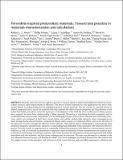| dc.contributor.author | Schulz, Philip | |
| dc.contributor.author | Schelhas, Laura T. | |
| dc.contributor.author | Holder, Aaron M. | |
| dc.contributor.author | Stone, Kevin H. | |
| dc.contributor.author | Perkins, John D. | |
| dc.contributor.author | Vigil-Fowler, Derek | |
| dc.contributor.author | Siol, Sebastian | |
| dc.contributor.author | Scanlon, David O. | |
| dc.contributor.author | Zakutayev, Andriy | |
| dc.contributor.author | Walsh, Aron | |
| dc.contributor.author | Smith, Ian C. | |
| dc.contributor.author | Melot, Brent C. | |
| dc.contributor.author | Wang, Yiping | |
| dc.contributor.author | Shi, Jian | |
| dc.contributor.author | Marques, Francisco C. | |
| dc.contributor.author | Berry, Joseph J. | |
| dc.contributor.author | Tumas, William | |
| dc.contributor.author | Lany, Stephan | |
| dc.contributor.author | Stevanović, Vladan | |
| dc.contributor.author | Toney, Michael F. | |
| dc.contributor.author | Hoye, Robert L. Z. | |
| dc.contributor.author | Kurchin, Rachel Chava | |
| dc.contributor.author | Buonassisi, Anthony | |
| dc.date.accessioned | 2018-11-09T15:32:43Z | |
| dc.date.available | 2018-11-09T15:32:43Z | |
| dc.date.issued | 2017-03 | |
| dc.date.submitted | 2016-09 | |
| dc.identifier.issn | 0897-4756 | |
| dc.identifier.issn | 1520-5002 | |
| dc.identifier.uri | http://hdl.handle.net/1721.1/118978 | |
| dc.description.abstract | Recently, there has been an explosive growth in research based on hybrid lead-halide perovskites for photovoltaics owing to rapid improvements in efficiency. The advent of these materials for solar applications has led to widespread interest in understanding the key enabling properties of these materials. This has resulted in renewed interest in related compounds and a search for materials that may replicate the defect-tolerant properties and long lifetimes of the hybrid lead-halide perovskites. Given the rapid pace of development of the field, the rises in efficiencies of these systems have outpaced the more basic understanding of these materials. Measuring or calculating the basic properties, such as crystal/electronic structure and composition, can be challenging because some of these materials have anisotropic structures, and/or are composed of both heavy metal cations and volatile, mobile, light elements. Some consequences are beam damage during characterization, composition change under vacuum, or compound effects, such as the alteration of the electronic structure through the influence of the substrate. These effects make it challenging to understand the basic properties integral to optoelectronic operation. Compounding these difficulties is the rapid pace with which the field progresses. This has created an ongoing need to continually evaluate best practices with respect to characterization and calculations, as well as to identify inconsistencies in reported values to determine if those inconsistencies are rooted in characterization methodology or materials synthesis. This article describes the difficulties in characterizing hybrid lead-halide perovskites and new materials and how these challenges may be overcome. The topic was discussed at a seminar at the 2015 Materials Research Society Fall Meeting & Exhibit. This article highlights the lessons learned from the seminar and the insights of some of the attendees, with reference to both recent literature and controlled experiments to illustrate the challenges discussed. The focus in this article is on crystallography, composition measurements, photoemission spectroscopy, and calculations on perovskites and new, related absorbers. We suggest how the reporting of the important artifacts could be streamlined between groups to ensure reproducibility as the field progresses. | en_US |
| dc.publisher | American Chemical Society (ACS) | en_US |
| dc.relation.isversionof | http://dx.doi.org/10.1021/ACS.CHEMMATER.6B03852 | en_US |
| dc.rights | Article is made available in accordance with the publisher's policy and may be subject to US copyright law. Please refer to the publisher's site for terms of use. | en_US |
| dc.source | Other repository | en_US |
| dc.title | Perovskite-Inspired Photovoltaic Materials: Toward Best Practices in Materials Characterization and Calculations | en_US |
| dc.type | Article | en_US |
| dc.identifier.citation | Hoye, Robert L. Z., Philip Schulz, Laura T. Schelhas, Aaron M. Holder, Kevin H. Stone, John D. Perkins, Derek Vigil-Fowler, et al. “Perovskite-Inspired Photovoltaic Materials: Toward Best Practices in Materials Characterization and Calculations.” Chemistry of Materials 29, 5 (March 2017): 1964–1988 © 2017 American Chemical Society | en_US |
| dc.contributor.department | Massachusetts Institute of Technology. Department of Mechanical Engineering | en_US |
| dc.contributor.mitauthor | Hoye, Robert L. Z. | |
| dc.contributor.mitauthor | Kurchin, Rachel Chava | |
| dc.contributor.mitauthor | Buonassisi, Anthony | |
| dc.relation.journal | Chemistry of Materials | en_US |
| dc.eprint.version | Author's final manuscript | en_US |
| dc.type.uri | http://purl.org/eprint/type/JournalArticle | en_US |
| eprint.status | http://purl.org/eprint/status/PeerReviewed | en_US |
| dc.date.updated | 2018-11-05T18:15:43Z | |
| dspace.orderedauthors | Hoye, Robert L. Z.; Schulz, Philip; Schelhas, Laura T.; Holder, Aaron M.; Stone, Kevin H.; Perkins, John D.; Vigil-Fowler, Derek; Siol, Sebastian; Scanlon, David O.; Zakutayev, Andriy; Walsh, Aron; Smith, Ian C.; Melot, Brent C.; Kurchin, Rachel C.; Wang, Yiping; Shi, Jian; Marques, Francisco C.; Berry, Joseph J.; Tumas, William; Lany, Stephan; Stevanović, Vladan; Toney, Michael F.; Buonassisi, Tonio | en_US |
| dspace.embargo.terms | N | en_US |
| dc.identifier.orcid | https://orcid.org/0000-0002-7675-0065 | |
| dc.identifier.orcid | https://orcid.org/0000-0002-2147-4809 | |
| dc.identifier.orcid | https://orcid.org/0000-0001-8345-4937 | |
| mit.license | PUBLISHER_POLICY | en_US |
